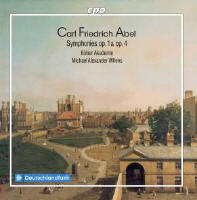Texte paru dans: / Appeared in: |
|
|
Outil de traduction ~ (Très approximatif) |
|
|
Reviewer: Raymond
Tuttle In the methodical manner to which we have become accustomed, CPO is continuing its survey of the symphonies by Carl Friedrich Abel (1723–1787). They come in sets of six—a function of their publication more than of their composition. We’ve already had opus 7, opus 10, and opus 17, and here, I believe, are the rest of them. I had hoped that this accelerated presentation meant that the label would be offering the two CDs for the price of one. Such does not appear to be the case, however, if a popular online retailer’s website is any indication. That’s a shame, because these two sets are of symphonies are appreciably shorter than the others.
I wrote about the opus 7 symphonies in Fanfare 41:1. I called them “consistently enjoyable and frequently distinctive.” The present symphonies, the first to be published, are no less so. Like the others, they are in three movements, with a slow movement in the middle. In other words, there is little to distinguish them from overtures, which is how they were described in London. And it was in London that the Köthen-born Abel came to settle around 1760, remaining there until his death. The opus 1 set was published shortly after his arrival in London, and the opus 4 set only a couple of years later.
These works do not set the world on fire, and it would fatuous to claim that they represent massive leaps forward in the development of the symphonic genre. In fact, there is much about them that is conservative, in addition to their structure. The oboes, for example, usually mirror the violins, or provide a simple harmonic underpinning. First movements are in rudimentary sonata form. Little happens that is unexpected, and frankly, little happens melodically that makes a lasting impression. Abel’s familiarity with the music of the Mannheim school of composers is suggested in many places. Still, for me, the total is greater than the sum of the parts. The music’s energy is infectious, and it makes a happy noise. It is never dull or mechanical, and, especially in these symphonies, the music never outstays its welcome. In both of these sets, there is only one movement that crosses the four-minute mark, and most of them don’t even make it to three. It’s hard for a competent composer to go astray when working with such a concise scale, and it’s hard for a competent listener to get bored by it!
Previous Abel issues from this label featured La Stagione Frankfurt conducted by Michael Schneider, and the Hanover Band conducted by Anthony Halstead. Willens’s ensemble is slightly smaller: six violins; one each of the remaining strings; two oboes; two horns; and harpsichord. I liked the energy of Schneider’s performances. Willens is a little more reticent, but he and the Kölner Akademie get the job done with spirit and good form. Forty years ago the idea that we would have had ready access to 30 symphonies by some composer named Abel would have seemed far-fetched, but times have changed, and adaptable ensembles such as the Kölner Akademie have made that change possible. | |
|
|
|
|
Cliquez l'un ou l'autre
bouton pour découvrir bien d'autres critiques de CD |
|




